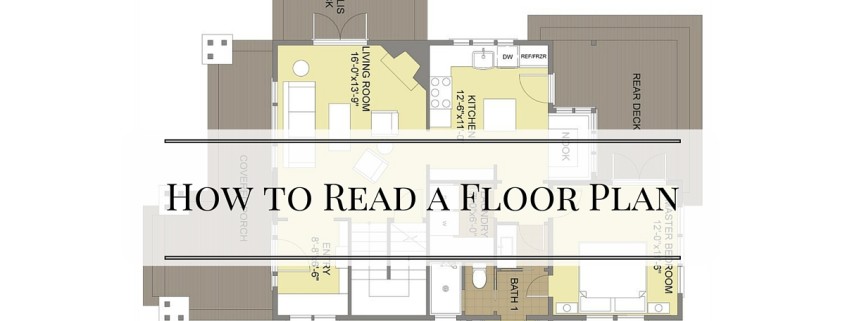How to Read A Floor Plan
When you are buying a house plan to build a custom home, it is essential to understand how to read a floor plan before you decide on the plan to buy. The floor plan gives essential details you need to know about how the final house will look and how well it will fit your lifestyle.
Floor plans are two-dimensional and give an aerial view of the house, so you can interpret what you see by imagining you are looking at the house directly from the top. This top cross-section view allows as many details as possible to be included in the floor plan. Some floor plans will include household items like furniture to give you a perspective of its real life dimensions. Such items also help you to visualize yourself living in the house so that you can alter the plan if need be to accommodate your personal preferences.
When the house has several floors, each floor will have its own floor plan, clearly marked and labeled. Some of the most common features of the house to note are the doors, windows, room dimensions and corridors. These will give you a good mental image about the kind of experience you can expect when living in the finished house.
So let’s go through some of the key features that you will find in a floor plan. Once you understand these features, you will be able to quickly make sense of any floor plan.
Key Floor Plan Features:
- Walls
- Doors
- Floors
- Stairs
- Windows
- Fixtures and Fittings
- Furnishings
Walls
Walls are one of the most important parts of any house as they determine the shape and size of the house. They are used to divide the house and to give it basic security features. Normally, a thick dark line is used to depict the external outer wall of the house, exterior walls are represented by thicker lines than interior walls. Most Floor plans will represent walls in a scale that represents their actual width.
Doors
Doors are represented on floor plans to include their relative position to the windows. The direction in which they open to is also indicated. This is important especially when planning how furniture will be arranged. The floor plan will also indicate on what side of the door handles will be. A swinging door is indicated buy a perpendicular line to the wall. An arc coming from the wall to the other end of that line indicates the direction to which the door opens.
Windows
The unfilled blocks along the walls are used to represent windows. If the windows open outwards, arcs like those used for doors will be used. A text notation is used to indicate any extra information about the window’s specific features.
Floors
In a floor plan, different floor coverings, materials or surfaces are indicated using light colored lines or shading.
Stairs
The stairs are represented by parallel lines in a rectangle with an arrow indicating which way is up. Other details are included in text notations. This includes the number of risers, specific sizes and the exact clearances required. Additional information about features like handrails may also be included to show safety features.
Fixtures and Fittings
Fittings and fixtures are sometimes included in form of diagrams in floor plans. This include things like bathtubs, shower-heads, toilets, sinks and their drain boards, ovens, dishwashers, hot water units and other similar items. These items are typically drawn to scale and most of them are represented using their standard symbols. A kitchen cabinet that is mounted overhead may be indicated by dotted lines.
Furnishings
Furnishings are included in many floor plans to provide context and scale. These include items like sofas, televisions, and dining tables. Different conventions and symbols are used to represent different materials. These are usually finer details that can be changed to suit your preferences.
A Floor Plan’s Title block
The administrative details of the housing project are typically included in the title block of the floor plan, either at the top or bottom of the pages. The details included in the title block are:
- The name of the drawing or title
- The designer, builder or architect’s names and contact details
- The drawing number or the revision number if it has been revised
The title block will also include the total area of the house in square feet, as well as other house specifics.
Figures and Symbols
Once you understand basic figures and symbols, you can quickly grasp where the doors, the windows, the bathroom(s), the bedroom(s), dining room and the kitchen are located. There are however finer details included in figures and symbols to make sure builder’s have the correct information to do their job right.
Some of the symbols and figures such as line thickness, direction of arrows, markings and numbers are there to guide the builder. The builder needs to know exactly what is required for the building to come out as planned.
Floor Plan Scale and Orientation
To consider a house plan for your lot, you’ll want to orient it correctly on the lot. Once you’ve done this, you should mark a north point on the floor plan to orient the house. Having north marked will give important clues like the effect of window on the cooling of the house and natural lighting. Windows need to be placed in a way to that they will take advantage of natural light. Other related plans such as drainage plans should also indicate their orientation to avoid costly mistakes.
Interior room measurements are often given for walls and floor areas to give a general idea of the room sizes. Often exterior dimensions are also noted.
Understanding the features above can help you to quickly grasp what is represented in a floor plan. Once you have a basic idea, it’s easier to imagine walking from room to room and will help you to consider finer details of the plan to ask about if you need to.



Leave a Reply
Want to join the discussion?Feel free to contribute!